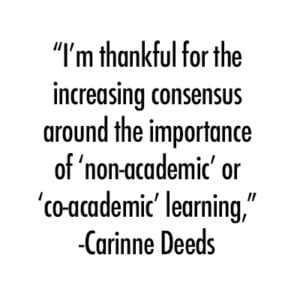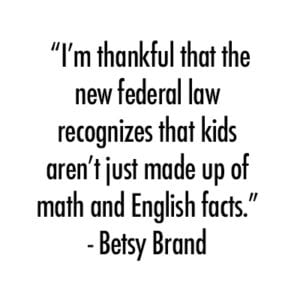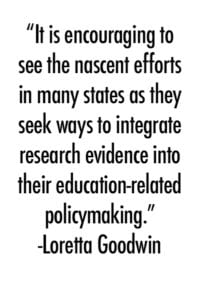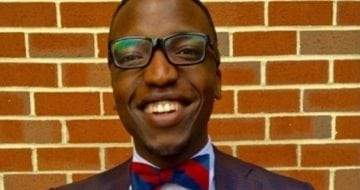For many, this time of year is a time for personal reflection, to think about for what and whom we are thankful. Beyond reflecting on our own good fortunes, it is also a time for those working in education and on behalf of youth to celebrate and show appreciation for the triumphs and successes of the past year. I asked my colleagues at the American Youth Policy Forum (AYPF) what they are thankful for in education and youth policy, and here’s what they had to say:
Promotion of a Well-Rounded Education
While the Every Student Succeeds Act (ESSA) was actually passed in late 2015, those of  us working across the field of education only began to understand the implications of the law this year. Betsy Brand, AYPF’s Executive Director, shared her appreciation for ESSA’s focus on “the whole child.” According to Brand, “For too long, schools focused on teaching a narrow curriculum linked to standardized tests. Now, states have much more freedom to think about assessments that measure growth across various dimensions.” ESSA requires states to incorporate a fifth “non-academic” indicator into their accountability systems, which could potentially measure items like school climate, social and emotional learning, or postsecondary readiness.
us working across the field of education only began to understand the implications of the law this year. Betsy Brand, AYPF’s Executive Director, shared her appreciation for ESSA’s focus on “the whole child.” According to Brand, “For too long, schools focused on teaching a narrow curriculum linked to standardized tests. Now, states have much more freedom to think about assessments that measure growth across various dimensions.” ESSA requires states to incorporate a fifth “non-academic” indicator into their accountability systems, which could potentially measure items like school climate, social and emotional learning, or postsecondary readiness.
Carinne Deeds, Policy Associate at AYPF, shared her excitement for the focus on social and emotional learning (SEL), specifically. “I’m thankful for the increasing consensus around the importance of ‘non-academic’ or ‘co-academic’ learning,” said Deeds. “We know that social and emotional skills – or what some call 21st century, employability, and even ‘non-cognitive’ or‘soft’ skills, such as communication, collaboration, and problem solving – are just as important for positive youth development as they are for post-secondary readiness.” Brand put it bluntly, “As someone who has always supported a youth development approach to preparing young people for careers, lifelong learning, and civic engagement, I’m thankful that the new federal law recognizes that kids aren’t just made up of math and English facts.”
Emphasis on Research Evidence in Policymaking
 ESSA also presents states with unprecedented flexibility over, and responsibility for, the use of evidence-based strategies to improve educational outcomes. More specifically, ESSA places a heightened importance on the use of research evidence as a critical tool for planning, collaborating, decision making, and continuous improvement in order to improve outcomes for youth. AYPF’s Senior Director Loretta Goodwin shared her appreciation for the growing interest of the use of research evidence in policymaking. According to Goodwin, “It is encouraging to see the nascent efforts in many states as they seek ways to integrate research evidence into their education-related policymaking— their exploration of how best to use research-practice partnerships, and their emphasis on data-driven interventions that best meet the needs of their schools and local contexts.”
ESSA also presents states with unprecedented flexibility over, and responsibility for, the use of evidence-based strategies to improve educational outcomes. More specifically, ESSA places a heightened importance on the use of research evidence as a critical tool for planning, collaborating, decision making, and continuous improvement in order to improve outcomes for youth. AYPF’s Senior Director Loretta Goodwin shared her appreciation for the growing interest of the use of research evidence in policymaking. According to Goodwin, “It is encouraging to see the nascent efforts in many states as they seek ways to integrate research evidence into their education-related policymaking— their exploration of how best to use research-practice partnerships, and their emphasis on data-driven interventions that best meet the needs of their schools and local contexts.”
Explicit Focus on Equity
As the reauthorization of a 1965 civil rights law, ESSA also returned to a more explicit focus on equity. As Goodwin pointed out, “Under ESSA, there are several opportunities to advance an equity agenda, including having high expectations of all students, ensuring that resources are allocated equitably, and measuring progress towards closing achievement gaps.”
The U.S. Department of Education (ED) has also released guidance and other  resources in recent months to help ensure the equitable inclusion of all students. Some examples include a Dear Colleague Letter with guidance on ensuring equity and providing behavioral supports to students with disabilities, as well as non-regulatory guidance on ensuring educational stability for children in foster care and education for homeless children and youths. I’m particularly excited about the resurgence of federal attention paid to school diversity. This includes a joint Dear Colleague Letter released by ED, the U.S. Department of Housing and Urban Development, and the U.S. Department of Transportation calling for cross-agency collaboration promote to socioeconomic and racial diversity in schools and communities and the Stronger Together bill that would create a $120 million competitive grant program to support new and existing voluntary efforts that promote racial and socioeconomic diversity in schools.
resources in recent months to help ensure the equitable inclusion of all students. Some examples include a Dear Colleague Letter with guidance on ensuring equity and providing behavioral supports to students with disabilities, as well as non-regulatory guidance on ensuring educational stability for children in foster care and education for homeless children and youths. I’m particularly excited about the resurgence of federal attention paid to school diversity. This includes a joint Dear Colleague Letter released by ED, the U.S. Department of Housing and Urban Development, and the U.S. Department of Transportation calling for cross-agency collaboration promote to socioeconomic and racial diversity in schools and communities and the Stronger Together bill that would create a $120 million competitive grant program to support new and existing voluntary efforts that promote racial and socioeconomic diversity in schools.
Overall, we at AYPF are thankful for the ways in which so many are making strides to improve education and the lives of all young people. We believe a focus on promoting a well-rounded education, supported by research evidence, and in the service of equity and opportunity for all is something to celebrate. Let’s keep that momentum going the rest of the year and into 2017.
Jenna Tomasello is a Policy Associate at the American Youth Policy Forum.







